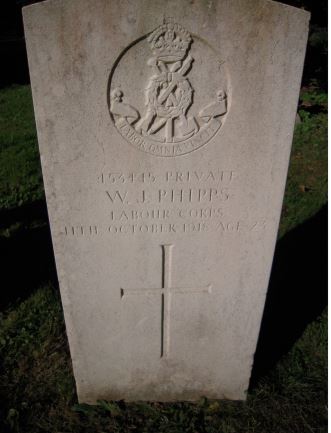599th Agricultural Company, Labour Corps

William John Phipps appears to have been an early war recruit for the Glosters, who was posted to work on the land, as part of the Labour Corps.
He was born mid-1895 at Watermoor, near Cirencester and was baptised on 4 August of that year. His parents were William Phipps (1873-1954), a farm labourer and his wife Ada Annie (née Wakefield; 1876-1939). William was the eldest of three sons, his brothers, Robert and James were born in 1898 and 1908 respectively.
In 1901 the family lived at Bourton Bridge, Lower Slaughter and at the time of the 1911 Census were located in Harnhill, south east of Cirencester, where the elder William was a shepherd and the younger and under-shepherd. On the day the census was taken, Ada Annie Phipps was staying with her sister at North Cerney.
Virtually no documentary evidence of William’s Army Service has survived but from what there is reasonable assumptions may be made. The volumes of Soldiers Died in the Great War (SDGW) show that he was a resident of Andoversford, when he enlisted in the Army at Cheltenham. Initially he joined the Gloucestershire Regiment and was given the number 17404. A check of similar numbers reveals that he was more than likely posted to the 10th Battalion, which had been formed in September 1914, as part of Lord Kitchener’s New Army and from November 1914 to May 1915 was billeted in Cheltenham. The 10th Glosters fought in the Battle of Loos, which opened on 25 September 1915. Was he wounded in that battle and following recovery in the UK transferred to the Labour Corps? This would be a reasonable assumption except for the fact he does not appear to have a Medal Rolls Index Card (stored at the National Archives) and the absence of this is a strong indicator that he did not serve oversees. It is possible that whilst in training his fitness fell short of that need for front line service or he suffered illness. Men posted to the Agricultural Companies of the Labour Corps. were not necessarily recruited from the ranks of the unfit (unlike Labour Battalions). Food production was vital to the war effort and as the war progressed major shortages appeared in the agricultural workforce. Army personnel were assigned to work on the land and farms were charged for their assistance. Some men were trained to drive tractors, used where older farmers were unable or unwilling to learn to drive them.
William had a background in farm work and may have been an ideal candidate for posting to the 599th Agricultural Company, Labour Corps. In the absence of any Army Service record it is impossible to determine when he switched from the Glosters and the reason for the switch.
Other than SDGW and the Commonwealth War Graves Commission (CWGC) Register, there are only two other sources of information, discovered so far. William’s entry in the Register of Soldiers’ Effects kept at the National Army Museum, states that he died at the Red Cross Hospital, Cirencester on 11 October 1918 (he was aged 23). A recently released Pension Record Card notes that the cause of death was pneumonia: he was very likely one of the victims of the second wave of ‘Spanish Flu’, sweeping the country at the time. His mother Annie, was the beneficiary for a bereavement allowance and it is noted she lived at Cerney Field, South Cerney.
Private William John Phipps was buried in the churchyard of All Hallows, South Cerney, where a standard CWGC headstone marks his grave. Interestingly and relatively rarely his headstone bears the badge of the Labour Corps; normally it is the badge of the unit from which the individual was transferred.
Researched by Graham Adams 19 November 2020
